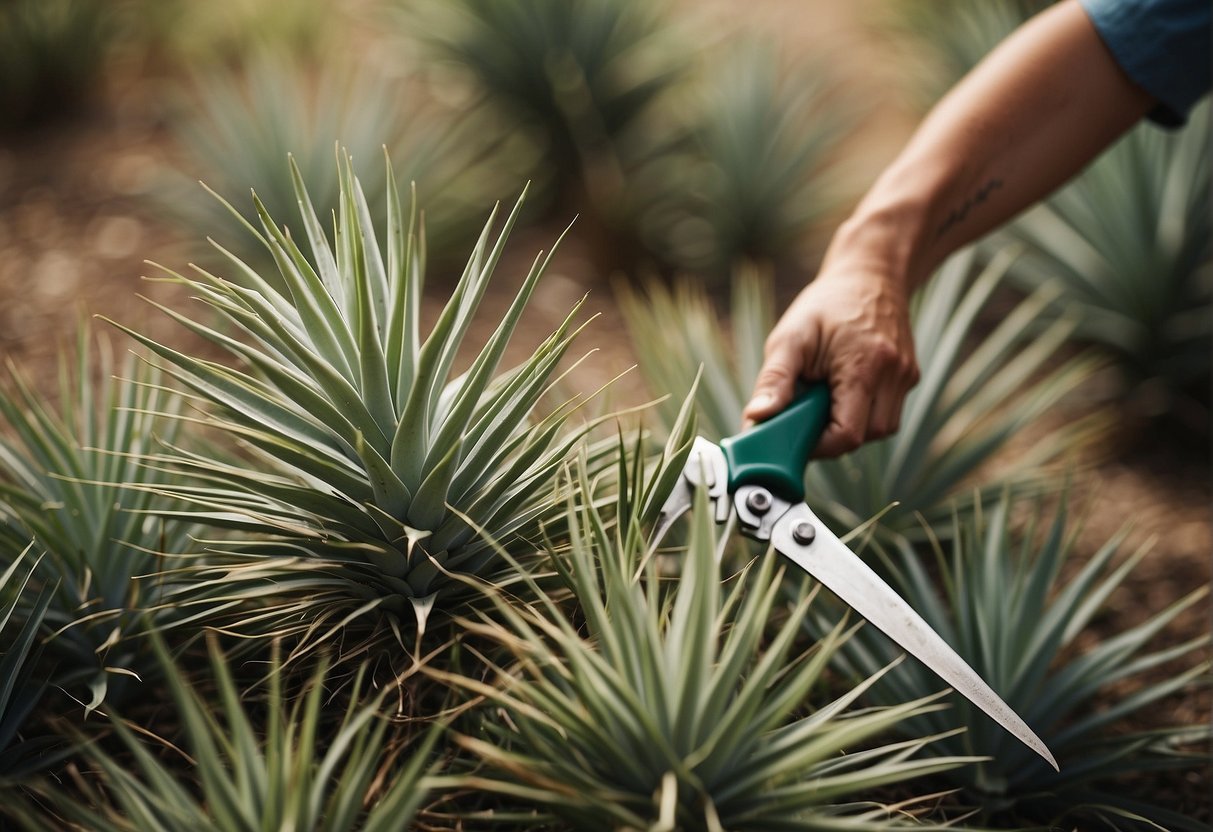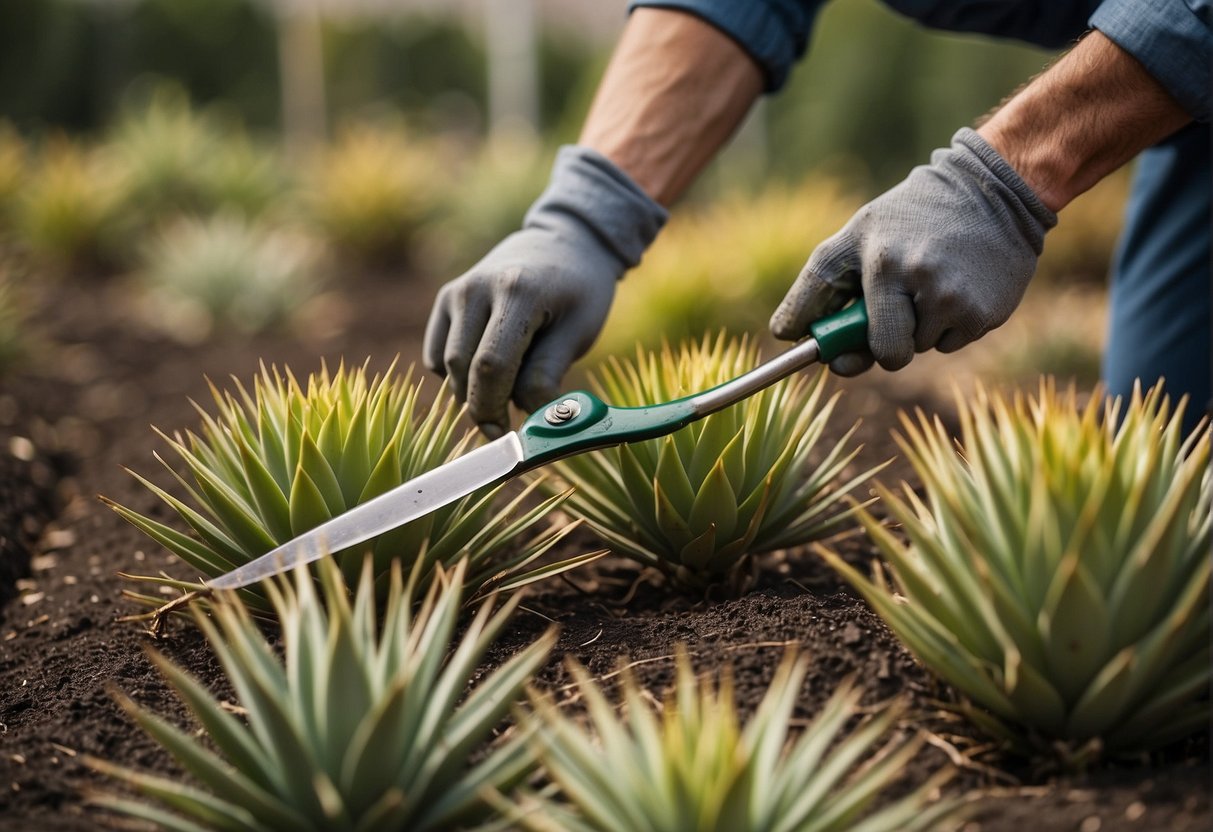How to Cut Yucca Plants: A Step-by-Step Guide
Trimming yucca plants may appear to be a challenging endeavor, yet it can easily become a clear and uncomplicated task when armed with the appropriate tools and methods. No matter if your goal is to trim your yucca to encourage vigorous growth or to reproduce new plants, being adept at correctly slicing your yucca is crucial for preserving its vitality and aesthetics.

Understanding the basics of yucca plant care is important before attempting to cut your plant. Yuccas are hardy plants that require minimal maintenance, but they do have specific needs when it comes to watering, sunlight, and soil. By familiarizing yourself with these needs, you can ensure that your yucca is healthy and ready for cutting.
When it comes to pruning yucca plants, there are a few key things to keep in mind. First, it’s important to use sharp, clean tools to avoid damaging the plant. Second, you’ll want to identify which parts of the plant need to be pruned and how much to remove. Finally, knowing when to prune your yucca is crucial to promoting healthy growth and preventing damage. With these tips in mind, you’ll be able to confidently prune your yucca and keep it looking its best.
Key Takeaways
- Understanding yucca plant care is essential to successfully cutting your plant.
- Proper pruning techniques and tools are crucial to maintaining plant health.
- Knowing when to prune your yucca can promote healthy growth and prevent damage.
Understanding Yucca Plant Care
Yucca plants are a great addition to any garden or indoor space. They are low-maintenance and can thrive in a variety of growing conditions. However, to ensure your yucca plants grow healthy and strong, it’s important to understand their care requirements.
Optimal Growing Conditions
Yucca plants prefer well-draining soil and full sun. They can tolerate some shade, but too much shade can cause the plant to become leggy and weak. When planting yucca outdoors, make sure the soil is well-draining and amend it with sand or gravel if necessary. Indoors, use a well-draining potting mix and place the plant in a sunny window.
Watering is another important aspect of yucca plant care. These plants are drought-tolerant and don’t need to be watered frequently. Water them deeply once a week during the growing season and reduce watering during the winter months. Overwatering can cause root rot, so it’s important to let the soil dry out between waterings.
Common Pests and Diseases
Yucca plants are relatively pest and disease-resistant. However, they can be susceptible to mealybugs and spider mites. These pests can be controlled with insecticidal soap or neem oil. It’s also important to keep an eye out for signs of root rot, which can be caused by overwatering or poorly-draining soil.
Fertilizer is not necessary for yucca plants, but if you choose to fertilize, use a balanced fertilizer once a month during the growing season. Avoid fertilizing during the winter months when the plant is dormant.
Overall, yucca plants are easy to care for and can add a unique touch to any space. By following these simple care guidelines, you can ensure your yucca plants thrive and remain healthy for years to come.
Pruning Yucca Plants

Yucca plants are known for their hardy nature and low-maintenance care, but pruning is an important part of keeping these plants healthy and looking their best. In this section, we’ll cover when to prune, tools for pruning, and pruning techniques to help you keep your yucca plants in top shape.
When to Prune
The best time to prune your yucca plants is in early spring, just before new growth begins. This is the time when the plant is dormant and pruning will not interfere with healthy growth. If your yucca plant is overgrown or has a lot of dead leaves, you can also prune it in the fall after the growing season has ended.
Tools for Pruning
To prune your yucca plant, you will need a few tools. A sharp knife or pruners are essential for cutting through the tough leaves and flower stalks. It’s also a good idea to wear protective gloves to avoid injury from the sharp leaves.
Pruning Techniques
When pruning your yucca plant, start by removing any dead or damaged leaves. These will not contribute to healthy growth and can be a breeding ground for pests and disease. Cut as close to the base of the plant as possible, taking care not to damage any healthy leaves.
If your yucca plant is overgrown, you can also remove the flower stalk. This will encourage new growth and help the plant maintain its shape. Cut the stalk as close to the base of the plant as possible, taking care not to damage any healthy leaves.
Overall, pruning yucca plants is a simple process that can help keep them looking healthy and vibrant. By following these tips and using the right tools, you can enjoy healthy growth and a beautiful plant for years to come.
Propagating Yucca Plants

Yucca plants are easy to propagate and can be done through several methods. In this section, we will cover the methods of propagation and the steps involved in transplanting and replanting yucca plants.
Methods of Propagation
There are three primary methods of propagating yucca plants – stem cuttings, offsets, and root cuttings. Stem cuttings are the most common method and involve cutting a stem from the parent plant and allowing it to root in a new location. Offsets are small plants that grow from the base of the parent plant and can be separated and replanted. Root cuttings involve taking a section of the parent plant’s root and replanting it.
To propagate yucca plants using stem cuttings, follow these steps:
- Choose a healthy stem from the parent plant that has new shoots and is at least 4 inches long.
- Using a sharp, sterile knife, cut the stem at a 45-degree angle.
- Remove the lower leaves from the stem, leaving only two or three at the top.
- Dip the cut end of the stem in rooting hormone powder.
- Plant the stem in a well-draining soil mix and water it thoroughly.
To propagate yucca plants using offsets, follow these steps:
- Wait until the offset is at least 4 inches tall.
- Use a sharp, sterile knife to cut the offset from the parent plant.
- Plant the offset in a well-draining soil mix and water it thoroughly.
To propagate yucca plants using root cuttings, follow these steps:
- Choose a healthy root from the parent plant that is at least 4 inches long.
- Cut the root into sections that are 2-3 inches long.
- Plant the root sections in a well-draining soil mix and water them thoroughly.
Transplanting and Replanting
Once your yucca plant has started to grow, it may need to be transplanted or replanted to a new location. Here are the steps involved:
- Choose a new location for your yucca plant that has well-draining soil and receives plenty of sunlight.
- Dig a hole that is twice the size of the plant’s root ball.
- Gently remove the plant from its current location, being careful not to damage the roots.
- Place the plant in the new hole and backfill with soil.
- Water the plant thoroughly.
By following these simple steps, you can propagate and transplant yucca plants with ease.
Maintaining Plant Health After Cutting
After cutting your yucca plant, it’s important to take steps to maintain its health and ensure it continues to grow properly. Here are some tips to help you keep your yucca plant healthy after cutting:
1. Monitor for Rot
Yucca plants are susceptible to rot, especially when cut. Keep an eye on the cut area for signs of rot, such as soft or discolored tissue. If you notice any signs of rot, cut away the affected area immediately to prevent it from spreading.
2. Care for the Plant
To promote healthy growth, continue to care for your yucca plant as you normally would. Water the plant regularly, but be careful not to overwater it. Yucca plants prefer well-draining soil, so make sure the soil isn’t waterlogged.
3. Watch for Signs of Damage
After cutting your yucca plant, it may be more vulnerable to damage from pests or harsh weather conditions. Keep an eye out for any signs of damage, such as holes in the leaves or wilting. If you notice any damage, take steps to address it as soon as possible.
4. Fertilize the Plant
Fertilizing your yucca plant can help promote healthy growth and prevent disease. Use a balanced fertilizer and apply it according to the manufacturer’s instructions. Be careful not to over-fertilize, as this can damage the plant.
5. Compost the Cuttings
If you’ve pruned your yucca plant, you can compost the cuttings to help promote healthy soil. Yucca plants are rich in nutrients, so adding them to your compost pile can help improve soil health and promote healthy plant growth.
By following these tips, you can help maintain the health of your yucca plant after cutting and ensure it continues to grow strong and healthy.
Frequently Asked Questions
What is the proper method for pruning an overgrown yucca plant?
When pruning an overgrown yucca plant, it is best to use a pair of sharp pruning shears or a saw to cut the stem as close to the base of the plant as possible. It is important to wear gloves and protective clothing when pruning yucca plants, as they have sharp leaves that can cause injury. Additionally, it is recommended to prune yucca plants in the spring or fall to avoid stressing the plant during extreme temperatures.
How can you propagate a yucca plant from cuttings?
To propagate a yucca plant from cuttings, it is best to take stem cuttings from the parent plant in the spring or summer. The cutting should be at least four inches long and should be allowed to dry for a few days before planting. Once the cutting has dried, it can be planted in a well-draining soil mix and should be kept in a warm, bright location until roots begin to form.
What are the best practices for trimming yucca leaves?
When trimming yucca leaves, it is important to use a clean, sharp pair of pruning shears to avoid damaging the plant. The leaves should be trimmed at the base of the plant, and any dead or damaged leaves should be removed as well. It is recommended to trim yucca leaves in the spring or fall to avoid stressing the plant during extreme temperatures.
How do you manage a yucca plant that has grown too tall?
If a yucca plant has grown too tall, it can be trimmed back to a more manageable size using a pair of sharp pruning shears or a saw. It is important to wear gloves and protective clothing when trimming yucca plants, as they have sharp leaves that can cause injury. Additionally, it is recommended to trim yucca plants in the spring or fall to avoid stressing the plant during extreme temperatures.
Is it possible to regrow a yucca plant after cutting it?
Yes, it is possible to regrow a yucca plant after cutting it. The plant will regrow from the base of the stem, and new shoots will begin to emerge within a few weeks. It is important to keep the plant in a warm, bright location and to avoid overwatering it during the regrowth process.
Should the brown tips of yucca plants be cut off for health or aesthetics?
Brown tips on yucca plants can be trimmed off for both health and aesthetics. If the brown tips are caused by overwatering or other environmental factors, trimming them off can help improve the health of the plant. Additionally, trimming off brown tips can improve the appearance of the plant and help it maintain a neat, tidy appearance.


